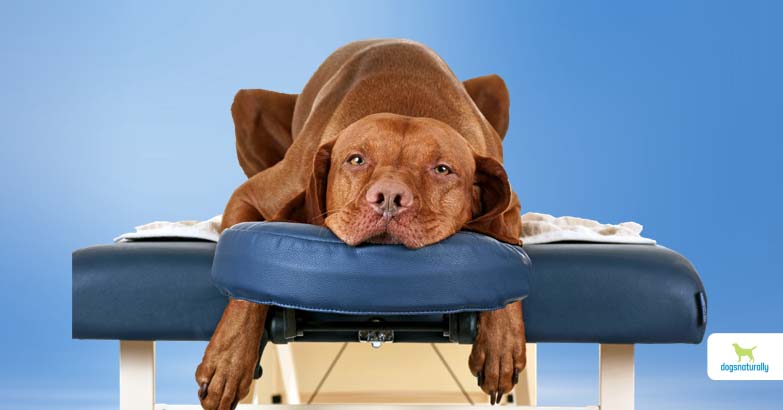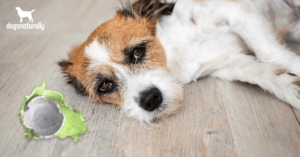Did you know that limping, anxiety, reduced appetite and even diarrhea can be signs of back pain in dogs?
The problem is, these signs can also mean something else. So how do you know if it’s a muscle sprain or something more serious, like Intervertebral Disc Disease (IVDD)?
And if it is IVDD, what can you do about it?
What Is IVDD In Dogs?
As dogs age, they can develop Intervertebral Disc Disease (IVDD). Intervertebral Disc Disease (IVDD) is a type of back pain in dogs. More specifically, IVDD is a spinal condition that can hinder your dog’s mobility.
Although it’s more common in smaller dogs, IVDD does happen to larger dogs as well.
IVDD develops when the cartilage between spinal discs begins to wear down. The disc becomes displaced and puts pressure on the spinal cord. This can result in extreme pain and even paralysis in some cases.
Obese dogs are especially prone to IVDD, but certain breeds are also more likely to get it than others. The most commonly affected breeds include Dachshunds, Beagles, Corgis and other small dogs. Among larger breeds, it’s most common in German Shepherds, Labradors and Dobermans.
Symptoms Of IVDD
It can be hard to tell when a dog has back pain. Sometimes the signs of back pain in dogs are very subtle, so you have to pay attention to your dog’s body language. If you think your dog may be suffering from IVDD, look out for the following symptoms:
- Reduced appetite and activity
- Weakness or reduced mobility of the limbs
- Hunched back
- Incontinence
- Reluctance to move the head and neck
- Increased anxiety
- Trembling or shaking
- Frequent collapsing
- Dragging one or more legs while walking
Conventional Treatment For IVDD
When your vet diagnoses your dog with IVDD, she may prescribe pain medication. But drugs like non-steroidal anti-inflammatories (NSAIDs) can be harmful to your dog.
In other cases, vets may suggest surgery. If your dog can’t walk around or move without pain, the connection from the brain to the body could be severely compromised. This is also the case if he has lost deep pain sensation. Unfortunately, in these extreme cases, surgery may be the only way to reconnect the brain and body.
But for less extreme cases, there are natural options that can aid in your dog’s recovery.
Manage IVDD Naturally
If your dog is dealing with IVDD, there are a few holistic options you can try.
1. Physical Therapy
Anyone who has undergone physical therapy knows how successful it can be. Physical therapy is useful after accidents or injuries. It can also help after conventional treatment to help rehabilitate your dog. Often, it benefits pets in the same way it benefits humans.
There are a few physical therapy exercises that help with IVDD (and general back pain in dogs). You may be able do these exercises with your pet at home … but always make sure to keep an eye out for signs of discomfort.
Confirm what exercises your pet is capable of with your vet. Even better … work with a trained veterinary physical therapist or veterinary rehab facility. Your dog’s ability to do these exercises will depend on the severity of her condition.
Massage For IVDD
The muscles surrounding the spinal cord can weaken and spasm in dogs with IVDD. A light massage will ease spasms and discomfort. But make sure to be gentle! You don’t want to press on a herniated disc.
Rub the muscles surrounding the spine in a circular motion. If your pet yelps at any point in the process, she’s in pain. Make a mental note of the tender area and move on. You may also want to ask an animal massage therapist to work on your dog.
Hydrotherapy For IVDD
Strap a life jacket on your dog and place her in the water. She may not like the idea at first … but she’ll warm up to it when she notices how weightless her joints feel.
When immersed in water, dogs can move their joints with less pressure. Hold your dog by the belly or upper chest so she can move and rotate her lower limbs in a swimming motion.
Note: Never leave your pet in a pool alone!
Balance And Stretching
Buy an inflatable exercise ball and lay your pet on top on her stomach. Place your arms on either side of your pet to prevent her from slipping off the ball. At the same time, roll the ball gently from side to side.
Your pet will extend her toes in hopes of reaching the floor, and stretch her limbs in the process. She will also strengthen her core by using those muscles to remain balanced on the ball.
2. Acupuncture
Acupuncture helps reduce the inflammation and pain associated with IVDD. It stimulates damaged nerves and muscles, improving circulation. For IVDD, needles go at the top of the spine between the shoulders and above the pelvis.
This can be such a relaxing process that your dog may even fall asleep. Researchers continue to look at acupuncture’s exact benefits for IVDD. But so far studies have shown positive results.
Electro-Acupuncture
Electro-acupuncture (EAP) is a more recent holistic IVDD treatment. With EAP, a machine sends small electric pulses through the needles into the muscles. Recent studies show that EAP is more effective than surgery for treating IVDD.
Remember that only licensed veterinarians should provide acupuncture and EAP.
3. Supplements For Dogs With IVDD
There are two supplements recommended for dogs with IVDD: turmeric and omega-3s.
Turmeric
Turmeric is popular among animals and humans suffering from chronic joint pain. Research shows that it reduces inflammation – a main cause of joint pain. It’s also good for heart and brain health (which also deteriorates with age).
The active compound in turmeric is curcumin. When looking for a supplement, find a high quality natural product. Synthetic curcumins won’t be water soluble.
Caution: Not all dogs tolerate turmeric. It’s a warming food, so if your dog seems to be warm most of the time (pants, sleeps on the cool floor), turmeric may not be for her. Turmeric can also interact with some medications, including anti-inflammatory and diabetes drugs. It may also interfere with some chemotherapy treatments. So if your dog’s on any medications, check with your holistic vet before adding turmeric to her diet.
RELATED: More natural joint pain supplements for dogs …
Omega-3s
Omega-3s offer similar anti-inflammatory benefits. Omega-3 helps support and improve joint health, heart health and brain development.
Research shows that omega-3 fatty acids can help regulate and reduce the effects of arthritis in dogs. But don’t just reach for a bottle of fish oil. Fish oil is extremely vulnerable to oxidative damage, which can actually make things worse.
RELATED: Why fish oil is an incomplete source to omega-3s …
Instead, feed small fish like sardines or mackerel. These contain fewer toxins and metals than other common sources of fish oil. Kelp is also a good option.
PRO TIP
Green lipped mussels are another great source of omega-3s. They’re sustainably grown and more bioavailable than fish oil. They provide more healthy fats than phytoplankton. And green lipped mussels are also a great source of superoxide dismutase (SOD). This antioxidant is even called the “king of antioxidants” because of it’s benefits.
4. Mobility Aids
In addition to the above treatment options, you may also want to try a mobility aid.
Equip your dog with a wheelchair or back brace to help her get around. Orthopedic braces for dogs help them regain their sense of independence. They are also an effective alternative to expensive surgery.
A sling or harness might also be beneficial for your pet. Use these to help your dog upstairs, into the car, or when navigating rough terrain. A leash causes added pressure to your dog’s neck, causing further spinal discomfort. Meanwhile, you can use a sling or harness around her hind legs for better support.
IVDD can limit your dog’s ability to do all the things dogs love to do – from chasing squirrels to chasing their tails. Combining natural supplements, therapy, and mobility aids will help with pain-free healing. Surgery and prescription pain medications don’t need to be the go-to solution.
Prevent Back Pain And IVDD In Dogs
The discs in your dog’s back do degenerate over time. This is just a normal part of aging. But there are things you can do to improve joint and spinal health.
- Regular, but appropriate exercise. Make sure that anything your dog is doing, like jumping from high places, is something that she can handle.
- Keep weight in check. Obesity can put pressure on various parts of the body.
- Feed a fresh, whole food diet that provides vitamins and minerals that support the whole body. Look for foods rich in glutamines like red meat and poultry. Boost the antioxidant intake. Make sure omega-3s are a staple. Avoid inflammatory foods like grains or anything synthetic.
Back pain in dogs may be common, but there are ways to prevent it and manage it naturally.
References
Knott L et al. Regulation of osteoarthritis by omega-3 (n-3) polyunsaturated fatty acids in a naturally occurring model of disease. Osteoarthritis and Cartilage. 1 Sep 2011;19(9):1150-7.
Awad AS. Effect of combined treatment with curcumin and candesartan on ischemic brain damage in mice. J Stroke Cerebrovasc Dis. 2011 Nov;20(6):541-8.
Kohli K et al. Curcumin: A natural antiinflammatory agent. Indian Journal of Pharmacology. 2005;37(3):141-7.
Joaquim JG, Luna SP, Brondani JT, Torelli SR, Rahal SC, de Paula Freitas F. Comparison of decompressive surgery, electroacupuncture, and decompressive surgery followed by electroacupuncture for the treatment of dogs with intervertebral disk disease with long-standing severe neurologic deficits. J Am Vet Med Assoc. 2010 Jun 1;236(11):1225-9.
Silva NEOF, Luna SPL, Joaquim JGF, Coutinho HD, Possebon FS. Effect of acupuncture on pain and quality of life in canine neurological and musculoskeletal diseases. Can Vet J. 2017;58(9):941-951.












